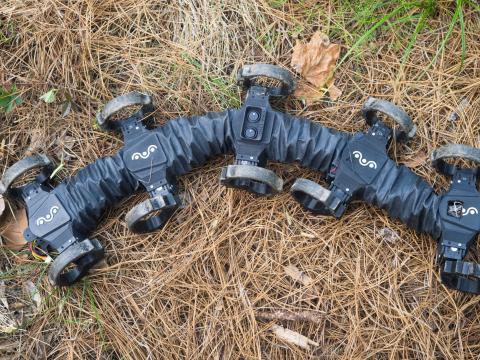NRL's MERLIN Robot Ready to Take First Steps
The U.S. Naval Research Laboratory’s (NRL’s) work on its Meso-scale Robotic Locomotion Initiative, known as MERLIN, is advancing, reports NRL roboticist Glen Henshaw.
The U.S. Naval Research Laboratory’s (NRL’s) work on its Meso-scale Robotic Locomotion Initiative, known as MERLIN, is advancing, reports NRL roboticist Glen Henshaw. The shoebox-size quadruped robot, meant to weigh in at 10 kilograms (22 pounds), features hydraulic-based legs for running, jumping or climbing—to navigate environments too complicated for tracked or wheeled robots.
And after several years of development, MERLIN is almost walking, Henshaw says.
“We were really interested in figuring out whether you could build a legged robot that small in size,” he says. “Because with legs you can suddenly start thinking about climbing and jumping over obstacles that are much larger than the robot. And so that’s what MERLIN is. It’s an effort to build a robot that you could put in a backpack and send out with Marines on patrol.”
MERLIN could be tossed over a wall or into a building that warfighters are breaching. Then it could quickly run through the building and map out the inside environment, Henshaw explains.
Through the development process, however, NRL researchers found that building small-legged robots is harder than constructing larger robots, mainly because many of the components are not commercially available in smaller sizes, Henshaw shares.
“For the legs, we had to learn how to develop hydraulic systems that are much smaller than what you would normally be able to buy from a parts manufacturer,” he says. Additive manufacturing also aided in MERLIN’s construction.
In addition, NRL engineers have made sure that MERLIN has enough energy via battery power to be able to move dynamically and jump. But with the battery power, “There’s an open question as to what kind of mission life we’re going to get,” Henshaw admits. “We just don’t know yet. We are going to have to try it out.”
He shares that the NRL is looking for a transition partner to take MERLIN to the next step. “Ideally, that would be another part of the Defense Department that was interested in having small quadruped robots,” Henshaw notes. MERLIN is a laboratory prototype, so it is not yet field-hardened. “I wouldn’t want to send it out with the Marines right now, but we designed it so that with a little more effort, we could provide a future version that was more environmentally hardened.”
MERLIN also could benefit from the NRL’s research into how a robot can better manipulate its environment, Henshaw adds. Currently, the NRL is using hand-designed algorithms, which can be limiting. “Ultimately, we want to be able to put machine learning on MERLIN so that it will learn to do new locomotion tasks on the fly,” he says.





Comments